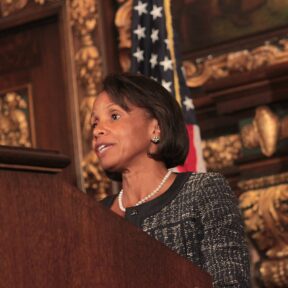
Wilhelmina Wright
Overview
* Was nominated by President Obama to the U.S. District Court for the District of Minnesota in 2015
* Views America as a racist nation infested with “white privilege”
* Supporter of school busing programs
* Supporter of affirmative action
Wilhelmina Marie Wright was born on January 13, 1964 in Norfolk, Virginia. She earned a bachelor’s degree in literature from Yale University in 1986, and a JD from Harvard Law School in 1989. Thereafter, Wright worked variously as: a law clerk for Judge Damon Keith of the Sixth Circuit Court of Appeals (1989-91); an associate with the law firm of Hogan & Hartson LLP (1991-95); an assistant U.S. attorney in the District of Minnesota (1995-2000); a judge in the Ramsey County, Minnesota District Court (2000-02); a judge in the Minnesota Court of Appeals (2002-12); and an associate justice in the Minnesota Supreme Court (2012-16). On April 15, 2015, President Barack Obama nominated Wright to the United States District Court for the District of Minnesota. Democratic Senators Al Franken and Amy Klobuchar, both from that state, led the way in guiding her nomination through the confirmation process. The Senate eventually confirmed Wright on January 19, 2016, by a 58-36 vote.
When Wright was a third-year Harvard Law School student in 1989, she contributed three articles to a UCLA Law Review special feature titled Racial Reflections: Dialogues in the Direction of Liberation. This feature was headlined by Harvard Professor Derrick Bell, the father of “critical race theory”—a school of thought which maintains that America is permanently racist to its core, and that consequently the nation’s legal structures are, by definition, discriminatory and invalid.
In her article titled “Questioning the Benefits of Desegregated Schools,” Wright, an African American, asserted that the cause of mass white migration out of U.S. cities was a strain of racism similar to what she professed to have observed in then-Supreme Court Justice William Rehnquist and President Ronald Reagan: “White people are running and hiding. Their mad scramble is aided by a Chief Justice who owned racially restrictive property and a presidential administration that believes bigotry, poverty, and poor educational opportunities for most public school students are the unavoidable fruits of a ‘thriving’ free market economy.” In the same piece, Wright lauded school busing as a well-conceived, court-ordered “integration mandate” that “was necessary” in order “to change some white minds about black incompetence,” “open doors for some blacks to walk through,” and “force white society to invest in the education of poor children of color.” She lamented, however, that despite busing’s success in “transform[ing] the student population [in some schools] from 100% white to a 60-40 white-to-black ratio,” the “education of black and white children” alike had nonetheless “suffered” because “teachers who felt federal judicial coercion in their classrooms [due to busing] responded with lethargy and disillusionment.” This was exacerbated, said Wright, by “the creation of ability grouping in education,” which had “resegregated the classrooms of many integrated schools” by making “classes for gifted students … almost all white,” and “vocational education courses and non-academic tracks … almost all nonwhite.” Moreover, Wright called for the implementation of “a curriculum that fosters student pride and self-respect by incorporating the political, social, and cultural contributions of people of color in American and world history.”
In a separate article, titled “Examining the Property of Rights in Whiteness,” Wright claimed that America continued to be plagued—as in the bygone era of “slavery, the Black Codes and Jim Crow laws”—by the persistent “belief that the lives and liberty of members of the Black race were worth less than the property of the white race.” While conceding that “few persons today would evoke that conception to justify their position against affirmative action,” she argued that intransigent white supremacism “remains a primary motivation” for that opposition. Wright further asserted that although “modern America has publicly rejected the notion that it is okay to advocate racial supremacy,” the country remained beset by the “equally damaging” belief that “property is worth more than life or liberty”—highly problematic in light of “the fact that whites own the vast majority of what Americans define as property.” She rejected the notion that property ownership, as emblematized by “the deed to a suburban home,” was “nonracist,” given society’s failure to likewise recognize “the opportunity to move out of a slum”—presumably with the help of government-allocated funds—as an alternate form of property to which everyone should be entitled.
In a third piece, titled “Black Success Rates Color-Blind Status,” Wright asserted that the media tended to emphasize “gender over race when it comes to achievements” of black women “other than teenage pregnancy.” This, she explained, was because the “white privilege” mindset that pervaded American culture was inclined to regard black skin as “integrally linked to inferiority and failure.” Declaring emphatically that “race will never be insignificant in this country,” Wright lamented that “typically the merits and achievements of blacks become racially neutralized”—i.e., their significance is dismissed as a mere by-product of American opportunity—“while the troubles of blacks are [considered] exclusively our own.”
Further Reading: “Wilhelmina Wright” (Ballotpedia.org); “Senate Okays Obama Judge Over Conservative Objections” (Washington Examiner, 1-19-2016); Racial Reflections: Dialogues in the Direction of Liberation (Fordham Law Archive of Scholarship & History, 1989); “Questioning the Benefits of Desegregated Schools” (by Wilhelmina Wright, 1989, p. 1070); “Examining the Property of Rights in Whiteness” (by Wilhelmina Wright, 1989, p. 1053); “Black Success Rates Color-Blind Status” (by Wilhelmina Wright, 1989, p. 1080).